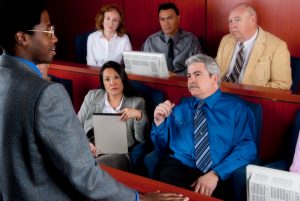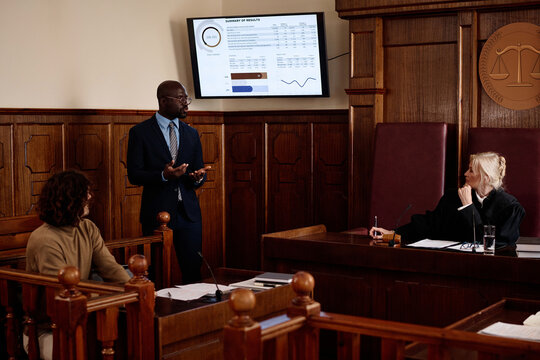The Function of Visual Aids in Successful Trial Presentations: A Guide for Lawyer
The Function of Visual Aids in Successful Trial Presentations: A Guide for Lawyer
Blog Article
Navigating the Intricacies of Trial Presentations: Tips for Seamless Shipment and Engaging Arguments
In the world of legal proceedings, the art of test presentation stands as an important determinant of success. The intricacies inherent in test presentations call for a delicate equilibrium of skill, skill, and approach.

Understanding Trial Purposes
To effectively navigate a test, it is important to have a clear understanding of the goals that need to be attained. Prior to entering the courtroom, lawful groups must define their objectives and preferred end results. These purposes work as leading concepts throughout the trial, forming approaches and influencing decision-making processes.
Understanding trial objectives involves a thorough analysis of the situation, lawful criteria, and the customer's finest passions. Trial Presentations. It needs a thorough examination of the realities, determining vital problems, and anticipating prospective difficulties. By setting certain and quantifiable objectives, lawyers can tailor their presentations and arguments to align with the wanted results
In addition, a clear understanding of trial objectives enables legal groups to focus on proof, witnesses, and lawful disagreements efficiently. It permits for the advancement of a systematic narrative that resonates with the court and jury, strengthening the overall case discussion.

Organizing Evidence Successfully
Having a clear understanding of test goals lays the foundation for arranging evidence properly in lawful procedures. By aligning the presentation of proof with the wanted end results of the trial, legal groups can reinforce their disagreements and boost their persuasiveness.
Another secret element in arranging proof properly is establishing a sensible flow. Presenting evidence in a sequential and coherent fashion can help build an engaging narrative that sustains the lawful debates being made. Furthermore, making use of visual aids such as charts, charts, or timelines can further improve the company of evidence and help in clarifying intricate relationships or series of occasions.
Moreover, making sure that all evidence provided is appropriate and permissible to the case is important. Inadmissible or unnecessary evidence can diminish the toughness of the disagreement and possibly damage the credibility of today celebration. A careful testimonial and choice process should be carried out to include just the most legitimately audio and impactful evidence in the trial presentation.
Crafting Convincing Stories
Crafting compelling stories plays a critical duty in offering persuasive disagreements throughout legal proceedings. A well-crafted story has the power to mesmerize the target market, evoke feelings, and eventually persuade the decision for the providing celebration. When constructing a narrative for a trial discussion, it is important to establish a clear storyline that highlights crucial points and attaches them in a systematic manner. Begin by detailing the realities of the situation in an engaging way, making sure that the sequence of occasions is simple to follow. Present personalities properly, offering history info that aids the target market recognize their motivations and actions. Additionally, incorporating brilliant descriptions and appealing language can bring the story to life, making it a lot more remarkable for the court and jury. By weaving together proof, statement, and legal disagreements into a natural and convincing story, lawyers can properly support for their customers and boost the probability of a desirable end result in the court room.
Understanding Visual Aids
Effective use visual aids is vital to enhancing the effect and clearness of test discussions. Aesthetic help, when made use of strategically, have the power to simplify complex information, strengthen bottom lines, and leave a this hyperlink lasting impression on the discretionary. To master visual aids in trial presentations, it is important to make sure that they are clear, succinct, and appropriate to the debates being made.
When including visual aids, such as charts, charts, timelines, or pictures, into a trial discussion, it is important to maintain them visually appealing yet expert. The visuals ought to complement the spoken debates, giving a graph of the details being talked about without frustrating the audience with unneeded details.
Moreover, practicing with the aesthetic aids beforehand is important to ensure a seamless delivery during the test. Acquainting oneself with the content, changes, and timings of each visual aid can aid keep the flow of the discussion and protect against technical glitches that might develop.
Delivering Impactful Closing Disagreements
An engaging closing debate This Site serves as the conclusion of a test presentation, encapsulating the core story and encouraging the judge and jury in the direction of a positive choice. Begin by laying out the primary disagreements that sustain your client's placement, highlighting why the proof provided throughout the trial supports your story.
Furthermore, integrating emotional charm can further enhance your closing debate. By humanizing the instance and attaching on an individual level with the decision-makers, you can stimulate empathy and understanding, affecting their understanding of the facts presented. Additionally, restating the lawful criteria that should be fulfilled for a desirable judgment can strengthen the validity of your setting. Ultimately, a well-crafted closing debate should leave a lasting perception, engaging the discretionary to regulation in your client's favor.
Conclusion
To conclude, mastering trial discussions includes recognizing objectives, organizing proof, crafting narratives, using visual help, and delivering impactful closing disagreements. By applying these strategies efficiently, attorneys can present their situation perfectly and make compelling arguments in the courtroom. It is critical to browse the intricacies of test discussions with precision and skill to achieve success in legal proceedings.
By aligning the discussion of evidence with the desired outcomes of the test, legal groups can reinforce their arguments and improve their persuasiveness (Trial Presentations). To grasp visual home help in trial discussions, it is vital to make certain that they are clear, concise, and pertinent to the arguments being made
An engaging closing disagreement serves as the end result of a trial discussion, enveloping the core narrative and convincing the court and jury towards a favorable choice. Begin by describing the major disagreements that sustain your client's position, stressing why the evidence offered throughout the test sustains your narrative.In final thought, grasping test presentations involves understanding goals, arranging evidence, crafting narratives, making use of visual help, and providing impactful closing arguments.
Report this page